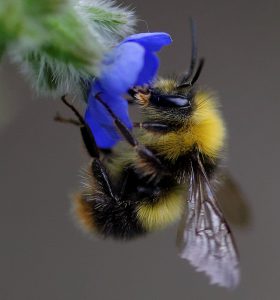2018: Make a difference by making it organic
Ten New Year’s Resolutions from The Organic Center
Groundbreaking studies in 2017 continued to prove the ability of organic agriculture to combat climate change, to feed the world sustainably, to protect the health of our children and ourselves, and much more. As is its annual tradition, The Organic Center has put together its list of top ten science-based New Year’s resolutions to help you make a difference in your world by making it organic.
One: Fight the causes of climate change.
 Photo credit: dlz design
Photo credit: dlz design
A ground-breaking study showed that organic soils are combating climate change by locking away carbon in long-term reserves that would otherwise be in the atmosphere. A collaboration between the National Soil Project at Northeastern University and The Organic Center compared over 1,000 soils from organic and conventional farms to understand how organic vs conventional agricultural management practices influence components of soil organic carbon. The study was the first to compare the amount of total sequestered soil organic carbon - found in the form of long-lived humic substances –between agricultural systems on such a wide scale basis. The results demonstrated that organic farms store more carbon in the soil, and keep it out of the atmosphere for longer than conventional farming methods.
Two: Protect the little guys.
 Photo credit: Brian Boucheron
Photo credit: Brian Boucheron
It’s the little teeny things in our soils – the invisible-to-the-eye microorganisms -- that make a big difference. Studies from across the globe demonstrated that organic farming systems boost a soil’s microbial diversity, and support more of the beneficial microbes that fight off the disease-causing ones. A study in the journal Frontiers in Microbiology looked at soil samples taken from 160 organic and conventional sample plots in the long-term Soil Health Experiment in the Netherlands and found that the microbial community in organically managed soils is more diverse than in conventional soils. The organic plots were also found to foster more of the microbes that suppress plant pathogens. Another 3-year study in Applied Soil Ecology found that organic banana plantations have better soil health and more microbial diversity than their conventional counterparts and a study from researchers in Sweden found that organic grain fields housed a greater diversity of beneficial arbuscular mycorrhizal fungi – which increase water and nutrient uptake in crops – than conventional grain fields.
Three: Feed the world sustainably.
 Photo credit: the bitten word.com
Photo credit: the bitten word.com
A study led by researchers at the Research Institute of Organic Agriculture (FiBL) in Switzerland indicates that global conversion to organic agriculture combined with reducing livestock feed from arable land, and substantial cuts in food waste, could help feed the world more sustainably in the future. The findings, published in the journal Nature Communications, show organic agriculture can help provide sufficient food and improve environmental impacts, provided that adequately high proportion of legumes are produced.
Four: Combat antibiotic resistance.
 Photo credit: US Department of Agriculture
Photo credit: US Department of Agriculture
Organic agriculture combats antibiotic resistance on multiple fronts. Studies show that by prohibiting antibiotic use in organic livestock production, organic farms and food harbor less antibiotic resistant bacteria than conventional. A 2017 study in Frontiers in Microbiology found that pigs raised on organic farms have significantly fewer strains of antibiotic-resistant Campylobacter, a bacteria known for its ability to infect humans from livestock, than pigs raised conventionally. Furthermore, a new study also demonstrates that commonly used herbicides can have the unintended consequence of increasing bacterial resistance to antibiotics, and highlights that organic can combat antibiotic resistance through the prohibition of most herbicides.
Five: Save the bees.
 Photo Credit: Adam Gold
Photo Credit: Adam Gold
In 2017 a series of high profile scientific papers were published in the scientific journal, Science, soundly confirming that neonicotinoid insecticides negatively affect insect pollinators. One study demonstrated that honey bee colonies in Canada’s corn growing regions exposed to neonicotinoids for the majority of their active season – three to four months – suffered increased bee mortality, lower social immunity and higher queen loss. Another study using large field experiments in Hungary, found that honey bees and wild bees were negatively affected by neonicotinoid exposure, with honey bee colonies experiencing declines of almost 25% after overwintering and successful reproduction dropping in wild bees. A final study sampled honey from across the globe and showed that 75% of their samples were contaminated with neonicotinoid pesticides at levels known to be dangerous to bees.
Six: Keep our farmers healthy.
 Photo credit: Taylor Johnson
Photo credit: Taylor Johnson
A study in Science of The Total Environment looked at the human health impacts of pesticide exposure. The study cited numerous environmentally induced diseases including short-term impacts such as skin and eye irritation, headaches, dizziness, and nausea as well as long-term impacts such as cancer, asthma, and diabetes. Researchers called for the development of eco-friendly pesticide alternatives and Integrated Pest Management techniques that do not rely on pesticides. Choosing organic production, which prohibits the use of toxic, synthetic pesticides reduce the risks to the farmers and farm workers that put the food on our plates.
Seven: Embrace diversity!
 Photo credit: Paul Horner
Photo credit: Paul Horner
Research published in Global Change Biology found that organic farming benefits biodiversity. Looking at data from around the world, the research found that overall, organic farms and fields with high levels of plant diversity increased both the abundance and the number of species of beneficial insects such as pollinators and pest predators. Another study published in the scientific journal Agriculture, Ecosystems & Environment found that organic vineyards in Spain are home to more butterflies and plants than their conventional counterparts. A final study from Japan confirms that bird diversity is greater on organic versus conventional apple orchards.
Eight: Know the true costs of pesticides.
 Photo credit: 401(k) 2012
Photo credit: 401(k) 2012
Critics of organic often cite the benefits of pesticide use, such as controlling pests and boosting yields, but economic models rarely incorporate hidden and external costs of pesticide use on human health and the environment. A study in Sustainable Agriculture Reviews estimates the costs of these negative impacts. The researchers analyzed 61 papers published between 1980 and 2014 and 30 independent datasets examining costs associated with the purchase and application of pesticides and the impact of treatments on humans and the environment. The study showed that past calculations have grossly underestimated the costs associated with pesticide use by omitting such information as fatalities due to chronic pesticide exposure. After further review of the data, researchers increased the cost calculation estimate tenfold, from $1.5 billion to $15 billion in the United States alone, and urged a re-evaluation of pesticide use because the costs associated with pesticide use may outweigh the benefits.
Nine. Honor the next generation
 Photo credit: John Grainger
Photo credit: John Grainger
A 2017 study in the International Journal of Environmental Research and Public Health found that exposure to multiple neurotoxic pesticides near the homes of pregnant women in farming communities is associated with lower IQs in their children. Researchers from the University of California, Berkeley observed that pesticide-use profiles of neurotoxic pesticides used close to the homes of pregnant women living in agricultural communities were associated with IQ deficits in the children later on in life. This study is important because most people are typically exposed to more than one chemical at a time.
Ten: Get a clean night’s sleep!
 Photo credit: Toshiyuki IMAI
Photo credit: Toshiyuki IMAI
A study published in Chemosphere found that bed sheets tested positive for some of the highest levels of flame retardants, highlighting the potential risk for exposure via the skin, especially through dust in bed sheets. “More human exposure pathways other than dust ingestion should be considered, such as the dermal contact with beddings and furniture,” the authors concluded.


